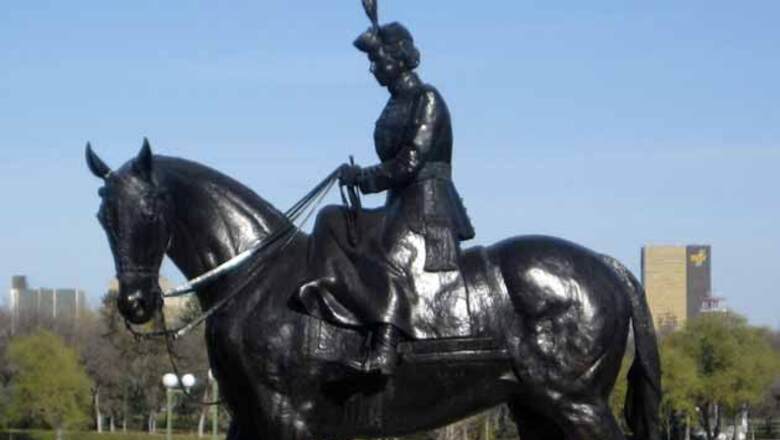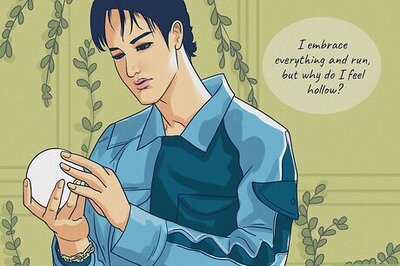
views
New Delhi: Symbolising power and movement through centuries of kingship, the march of civilisation and modern living, horses remain vital to man's artistic imagination in the world of contemporary art.
The horse motifs in Indian and Asian art date back to the early Vedic age when migrants from Central and West Asia - from the Caucasian region - came to the subcontinent on horses.
In the ensuing millennia, horses galloped to the streets of haute art in the 20th century.
Kolkata-born NRI artist Aslam Shaikh, who has spent the last 18 years of his life in London and the Middle East, paints horses. His horses adorn Dubai's millionaire sheikhs' homes and that of fashion designer Armani.
The 42-year-old artist's horses have a surreal look to them - painted with cubic precision in raw acrylic shades and holy inscription of "Karvala" from the Quran. He is in India to paint a series of 21 large format horses, "Horses of Arabia", for an exhibition in Dubai in March.
The horses on the artist's canvas represent the angst of the Islamic festival of Muharram - "a connect between human sacrifice and god", the artist explains.
"Horses to me represent movement and the moment. 'Horses of Arabia' represents good over evil. The concept is mystical and mythological. Horses were central to the Ramayana and the Mahabharata," Shaikh told IANS.
The artist, who studied restoration in London, says he has been "influenced by old masterpieces".
Shaikh says 'Horses of Arabia' will be followed by "Warrior Horses of Chhatrapati Shivaji" for a Mumbai exhibition followed by "Celestial Horses" from Indian epics for one in Delhi. Each series will feature 21 horses.
Part of the proceeds from his exhibition will go to a shrine.
Art promoter Nina Pillai of Triveda Art says: "Horses have an epic quality. The animal is a universal symbol of power. The horse power drives. Shaikh's 'Horses of Arabia' are the prophet's horses - the ones that his sons rode."
"In the Ramayana, horse is a symbol of victory. The Ashwamedha horse - ceremonial victory horse that king Rama sent across the country as a seal of dominion over the land - was only stopped by his sons Luv and Kush," she adds.
Pillai is promoting Shaikh's series of horses in Dubai and India.
Art writer and critic Aruna Bhowmick says "every culture has its own interpretation of horses as a leitmotif because art portrays mythology and epic".
In contemporary Indian art, the two most popular horse motifs are of M.F. Husain and Kolkata-based Sunil Das.
Husain's horses have run a long road - they are famous worldwide for their mobility on the canvas and cubic structure that breathe raw power into their galloping forms.
Art historians say Husain's galloping horses are reminiscent of Duldul - a celestial horse that belonged to Hazarat Imam Husain, prophet Mohammed's martyred grandson. They were inspired by Muharram processions that Husain saw as a child.
In Pandharpur, a temple town in Maharashtra, where Husain was born, he often watched one of his grandfather's friends work with horses. It bred in him a love for the animal.
In Santiniketan, Husain met Xu Beihong, the celebrated Chinese painter of horses, who was loved by Rabindranath Tagore.
Xu (1895-1956) is often hailed as the pioneer of "galloping horse" in contemporary art. His ink and pen drawings of moving horses - with deep interplays of light and shade and fluid strokes - commanded hefty price at sales worldwide.
A Chinese reform artist, Xu gave his horses a freshness and life that the traditional Chinese horses lacked. He combined ancient Chinese and European techniques.
Das, India's popular post-modern artist, owes his career to his horses. "I must have painted 7,000 horses during 1950-1960."
His affair with horses began as a student. "A teacher asked me to draw animals. I spent days and nights in the stable of the Kolkata mounted police. When I got my first award for drawing a horse, the people at the stable were very happy."
Das' horses are powerful, stylised and sombre - painted in charcoal and ink on paper.
Amitesh Verma's horses are big and powerful - waiting to take the world by storm. "He is the only artist among the younger contemporary artists in India who draws horses with charcoal on canvas," says artist Jeram Patel.
Verma from Bihar fell in love with horses in 2001 when he begun sketching their anatomical forms near the Delhi Race Course. His horses are in the tradition of Husain and Das - though less stylish and closer to life.
"The stark raw power of the animals draws me to them," Verma told IANS.



















Comments
0 comment